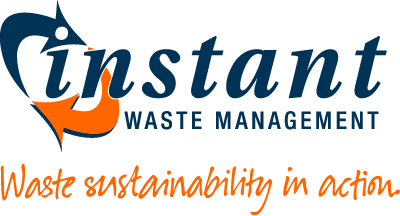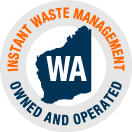The Importance of Recycling Construction & Demolition Excess: Why IWM is an Industry Leader in Waste Management
23 June 2017
Travel to any building site in Perth and you’re likely to see a decent sized skip bin or two out the front. Filled with rubble, sand, building excess and a few iced coffee cartons, how it’s all disposed of plays a pivotal role in reducing the amount of construction waste which gets dumped into landfill. Most of this waste usually does end up in landfill. But times are changing.
There’s no denying that landfill waste isn’t good. Construction excess that ends up in landfill can take centuries to degrade, which is harmful to the environment and consumes valuable landfill space – space we’re running out of rapidly. At Instant Waste Management, we aim to change this. As the largest recycling plant of its kind in Western Australia, we turn a profit by recycling material that would otherwise go to landfill. This includes construction and demolition waste – of which we recycle around 90%.
To reduce the amount of unused material that ends up in landfill, we have developed a state-of-the-art facility which enables a high level of co-mingled waste to be collected from building sites. Our services are specifically designed to reduce construction excess and get projects and new developments the green star of approval. Here’s a rundown on what makes us the industry leader in waste management.
Waste Management Consultancy: Understanding What Happens to Your Waste
A key part of ensuring a successful waste management plan is waste management consultancy. This process involves meeting with clients and architects to determine the required size of bin stores in new building projects and to discuss how the waste will be managed once the building is fully operational, as well as during the construction stage.
At IWM, we provide advice during the Design Approval Process (DAP) for major companies such as Mirvac and Psaros Property Development, as well as specialist architects Dryka & Partners. Through efficient and tailored consultancy, we will not only provide a seamless waste management service for the demolition project, but also analyse how the new development will impact the local area and manage the commercial or residential waste management streams after construction has finished.
Recently our State Resource Development Manager spoke with ABC Radio Perth to discuss what happens to construction and demolition waste. From a typical building site in Perth, materials such as concrete, brick and timber can all be recycled. We utilise screens which sort the waste by weight and size. Giant magnets remove the metal and floatation tanks separate timber. Heavier woods like Jarrah and hard wood are picked out before and after the floatation tank to eliminate any impurities. Once the wood waste is good to go, it’s sent off the recycling facility to be processed and turned into compost. Paper and cardboard are also screened and reused. The concrete and bricks are crushed down to be utilised as road base, while metal is usually sent back to China to be reprocessed for reinforcement in concrete structures.
The infamous Taj on Swan in Peppermint Grove is a prime example of a demolition project where the waste was ground up for road base. After sitting derelict for years, the half-built mansion was forcibly demolished by the local council before being recycled & the waste and turned it into rubble to go under asphalt for minor roads.
Recycling Building Material in Perth: Supply and Demand
Each year, 3.4 million tonnes of building and demolition waste is produced in WA, however there is a supply and demand issue in Western Australia due to the limited infrastructure. Not everyone wants recycling facilities in their area, which means there is more demand for the facilities than there is the ability to meet the demand.
IWM’s recycling facility is only 11km out of Perth. Our setup, combined with those of our sister companies, can process around 1.8 million tonnes of the construction and demolition material each year. However, there is only about 2.5 million tonnes worth of license capacity for buildings like this to process the waste. Thus, we need more recycling facilities.
Waste Auditing
Another essential part of waste management we offer at IWM is waste auditing. This provides you with a comprehensive analysis of your company’s waste stream and what types of recycled materials can be salvaged from it. Waste audits are important to understanding how much waste your facility generates and how much of the materials can be recovered for recycling or discarded. Waste auditing assists with town and city planning. We will provide advice to managing waste to the local Government too. Recently, we conducted a waste auditing project for the second largest employer in the state.
Green Building Event
In June 2017, Donald Trump withdrew from the Paris climate change agreement. Ironically, the Green Building Council of Australia (GBCA) held their Green Building event on the same day. Green Building Day was proudly sponsored by IWM to raise awareness about the probability of human extinction if we didn’t align with the Paris Accord. The annual event brings together the industry’s leading innovators and thinkers to discuss how we can slow down the effects of global warming. IWM strive to not only support the event, but to continually improve the greenhouse gas savings from recycling and recovering energy from waste.
Did You Know, It’s Cheaper to Recycle than Send Waste to Landfill?
Before the introduction of the landfill state levy, it was cheaper to dump waste to landfill. Since the change has taken place however, it’s now more cost-effective to recycle. Currently, it costs $50 per tonne to send construction and demolition waste to landfill. By July 2018, this will increase to $70 a tonne. Because of the costs, inconvenience and environmental impact of dumping waste to landfill, it makes sense to recycle.
GBCA incentives encourage building companies to recycle. For the individual homeowner though, we strongly recommend that you engage with your builders and find out how the waste being managed. Make sure the recyclable materials are being recycled and ask if they can utilise recycled materials in the construction too. If you’re not using recycled materials, you won’t generate that economy to feed the market and make it profitable for facilities like Instant Waste Management to recycle.
See How it all Goes Down at IWM
To give you the best idea on how we turn your construction waste into usable materials, we run educational tours at our Material Recovery Facility (MRF). This allows you to safely see how we process over 200,000 tonnes of waste each year. Tours run for approximately 45 minutes free of charge. This diversion process is paramount to improving WA’s waste recovery performance and we urge as many people as possible to come see it in action.
For more information about our services or why IWM is an industry leader in waste management, contact one of our staff today to find out how we can help with your next project.









